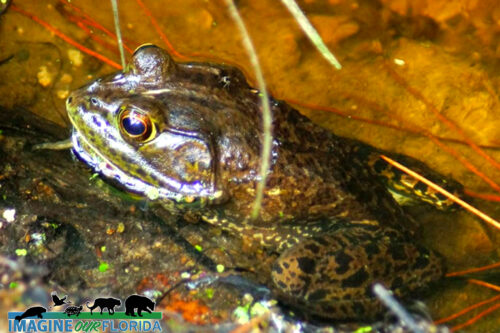American bullfrogs are the largest frogs in North America, measuring up to 203 mm long. They often have markings of spots or blotches with colors ranging from brown to green. The back legs are completely webbed. They can be sexed by observing the size of the tympanum, which is larger than the eye in males and equal or smaller in females. Sexes can also be distinguished during mating by observing the color of the throat. Males have yellow throats, and females have white (Bruening 2002).
The American bullfrog’s native range extends from central Florida to Southern Maine and across the Midwest as far as Nebraska and Central Texas. They are considered non-native in patches of the Western United States, California, Hawaii, and Puerto Rico (McKercher and Gregoire 2022).
Water is essential for their survival. Bullfrogs prefer warm, still, shallow water such as ponds, lakes, rivers, or bogs. They are becoming more common in waters with anthropogenic pollution. These areas are warmer, making them ideal for food, reproduction, and protection (Bruening 2002).
Tadpoles feed on plant matter. American bullfrogs consume a variety of animals. These include small snakes, insects, worms, crustaceans, other frogs, and eggs of fish or other amphibians. They are also cannibalistic and have been known to consume some bats (Bruening 2002).
Sexual maturity occurs at three to five years. Reproduction occurs externally. Females lay about 20,000 eggs in a floating mass between May and July in northern regions and February to October in southern ones. Four days after fertilization, tadpoles emerge from the eggs. They will remain in tadpole form for three years (Bruening 2002).
This species was previously classified as Rana catesbeiana (NCBI 2020). Red leg syndrome has been shown to increase bacterial infections on the skin of Florida bullfrogs (Wei et al. 2023). They are also vulnerable to bacterial infections by Klebsiella pneumoniae (Lin et al. 2023).
Lin H, Sun J, Ma J, Qin Z, Jiang B, Li W, Wang Q, Su Y, Lin L, and Liu C. 2023. Detection and quantification of Klebsiella pneumoniae in American bullfrog (Rana catesbeiana) by Taqman MGB probe real-time fluorescence quantitative PCR. Aquaculture 568: 739339.
[NCBI] National Center for Biotechnology Information. Taxonomy: a comprehensive update on curation, resources, and tools. Database (Oxford). [updated 2020 Jan 1; accessed 2023 April 11]. https://www.ncbi.nlm.nih.gov/Taxonomy/Browser/wwwtax.cgi…
Wei D, Cheng Y, Liow W, Yu Q, Shi J, Xia X, Chen W, Han S, and Li P. 2023. Composition and function of the skin microbiota were altered of red leg syndrome in cultured bullfrog (Rana catesbeiana). Aquaculture reports 29: 101487
Bruening S. 2002. “Lithobates catesbeianus” (On-line), Animal Diversity Web. [Accessed 2023 April 11]: https://animaldiversity.org/acco…/Lithobates_catesbeianus/
McKercher L, and Gregoire DR. 2022. Lithobates catesbeianus (Shaw, 1802): U.S. Geological Survey, Nonindigenous Aquatic Species Database, Gainesville, FL. [Accessed 2023 April 11]. https://nas.er.usgs.gov/queries/factsheet.aspx?SpeciesID=71

